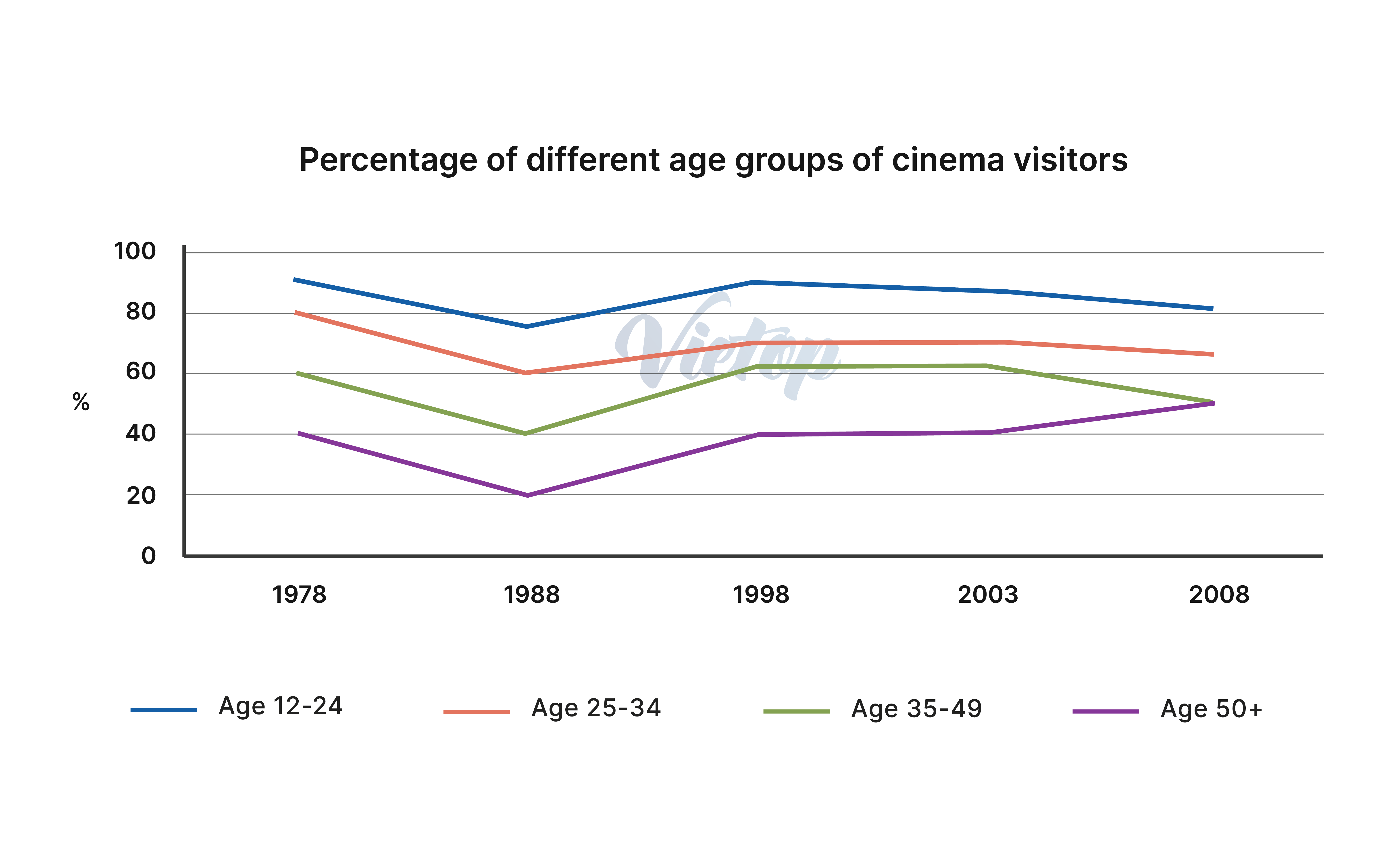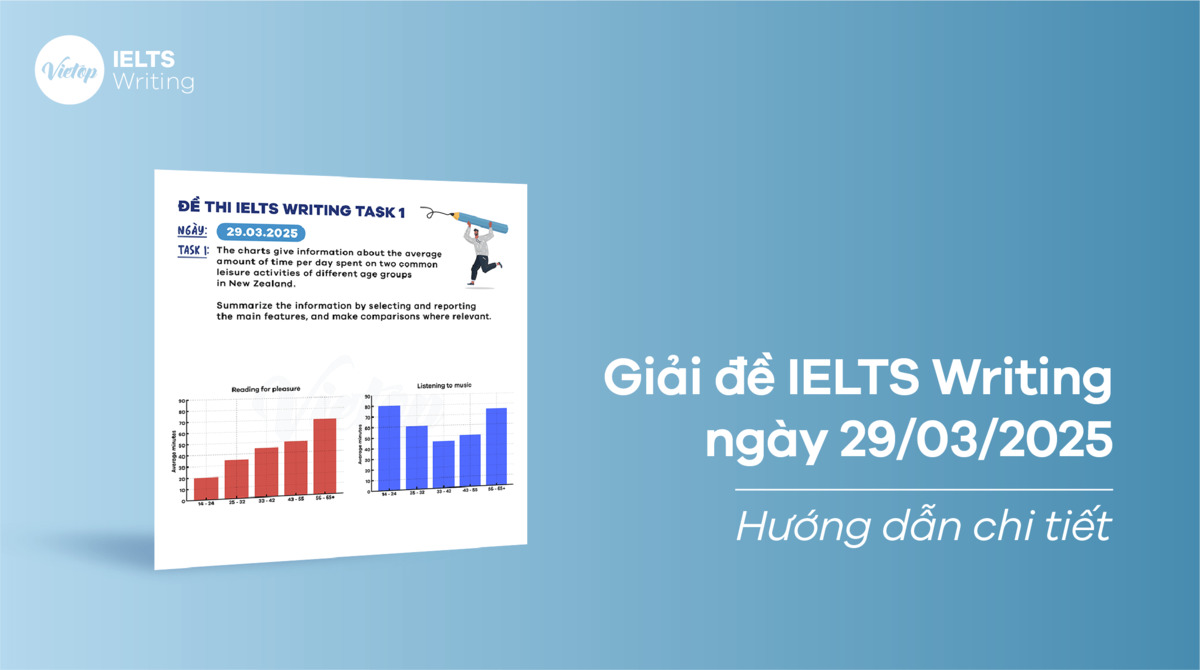Vietop gửi bạn giải đề IELTS Writing ngày 25/11/2023 bên dưới nhé! Các bạn theo dõi và ôn luyện IELTS Writing thật tốt nhé!
IELTS Writing task 1
The line graph shows the percentage of different age groups of cinema visitors in a particular country from 1978 to 2008. Summarise the information by selecting and reporting the main features, and make comparisons where relevant.

Bước 1: Lập dàn ý
Đoạn tổng quan: Tỷ lệ người xem phim trên tất cả các nhóm tuổi có khuynh hướng dường như tương tự, với con số của chúng không trải qua bất kỳ thay đổi đáng kể nào đến cuối khung thời gian.
Đáng chú ý, nhóm tuổi trẻ nhất, từ 14 đến 24 tuổi, luôn giữ tỷ lệ tham gia cao nhất, trong khi nhóm người cao tuổi từ 50 tuổi trở lên luôn giữ tỷ lệ thấp nhất.
| Thân bài 1 | Thân bài 2 |
| Trong năm đầu tiên, tỷ lệ người trẻ từ 14-24 tuổi đứng đầu nổi bật, chiếm gần 90%. Mặc dù có sự giảm đáng kể xuống khoảng 75% vào năm 1988, tỷ lệ tham gia rạp của nhóm tuổi trẻ sau đó đã trở lại con số ban đầu trước khi giảm một cách nhẹ nhàng nhưng ổn định đến cuối giai đoạn là 80%. Một xu hướng tương tự được nhận thấy ở giữa những người xem phim ở độ tuổi từ 25-34, chứng kiến sự suy giảm đáng kể từ 80% xuống còn 60% trong thập kỷ đầu tiên. Điều này được theo sau bởi một sự tăng nhẹ lên khoảng 70% vào năm 1998, và một giai đoạn ổn định trong 10 năm cho đến năm 2008. | – Chuyển sang hai nhóm tuổi lớn hơn, một xu hướng tương tự rất đáng chú ý. – Mặc dù giảm từ 60% xuống 40% trong 10 năm đầu tiên, tỷ lệ của nhóm tuổi 35-49 tuổi đã quay trở lại con số ban đầu. Điều này được theo sau bởi một giai đoạn năm năm trong đó dữ liệu của nó duy trì ổn định, sau đó giảm và đến năm cuối cùng đã giảm xuống khoảng 50%. – So với giai đoạn từ năm 1978 đến năm 2003, những người trên 50 tuổi thăm rạp hầu như chính xác lặp lại xu hướng biến động của nhóm 35-40 tuổi, mặc dù ở mức độ thấp hơn một cách đáng kể (khoảng 10% thấp hơn). Sự khác biệt duy nhất được thấy trong năm năm cuối cùng, khi nhóm tuổi cao nhất tăng nhẹ, đạt đến sự tương đồng với những người từ 35 đến 49 tuổi (gần 50%). |
Bước 2: Hoàn thành bài luận
The given line graph presents the proportion of moviegoers categorized by four distinct age groups over a course of 30 years, spanning from 1978 to 2008.
Overall, the percentage of cinema visitors across all age groups exhibited somewhat similar patterns, with their figures generally not experiencing any significant changes by the end of the time frame. Notably, the youngest demographic, aged 14 to 24, consistently held the highest attendance rate, while the elderly from the age of 50 and over consistently had the lowest.
In the first year, the percentage of young people aged 14-24 stood out prominently, accounting for nearly 90%. While a notable decline to around 75% was observed in 1988, cinema attendance rate in the youngest age category then bounced back to its initial figure before dropping minimally but steadily to end the period at 80%.
A parallel pattern was discernible among cinema visitors at the ages of 25-34, witnessing a substantial decline from 80% to 60% in the first decade. This was followed by a marginal growth to approximately 70% in 1998, and a subsequent 10-year period of relative stability until 2008.
Moving on to the two older age groups, a strikingly similar trajectory was evident. Despite falling from 60% to 40% in the first 10 years, the proportion of 35-49-year-olds precisely went back to its initial level. This was followed by a period of five years during which its data remained constant, after which it fell and by the final year had dropped to roughly 50%.
In comparison, from 1978 to 2003, people over the age of 50 who visited the cinema almost exactly mirrored the 35-40 group’s fluctuating trend, although it remained at a fairly lower level (approximately 10% lower). The only difference was seen in the final five years, when the oldest age bracket rose slightly, reaching parity with those who were 35 to 49 years old (nearly 50%).
Nỗi khó khăn mà hầu hết các bạn ôn thi IELTS gặp phải là khó khăn trong việc phân tích đề và kiểm soát lỗi sai khi trình bày ý tưởng. Để cải thiện kỹ năng viết, bạn cần có người hướng dẫn, chấm chữa chi tiết từng lỗi sai. Với khoá học IELTS 6.0 tại Vietop, thầy cô 8.0+ IELTS sẽ đồng hành cùng bạn trong việc cải thiện kỹ năng viết chi tiết giúp nâng cao band điểm IELTS.
Bước 3: Từ vựng về mô tả nhóm tuổi
- … among 6-11-year-olds
- = …. 6- to 11-year-olds (6- to 11-year-old girls) (11-year-olds ; 11-year-old girl)
- = …. those aged 6-11
- = …. those at the age of 6-11
- = …. in the 6-11 age group / age band / age bracket
- = …. who fell into the age group of 6-11
- = … who were 6 to 11 years old
- = … whose age ranged from 6 to 11
- = … between the ages of 6 and 11
- = the youngest age group = the youngest category = the youngest (plural Noun)
Xem thêm:
- Giải đề IELTS Writing ngày 18/11/2023
- Giải đề IELTS Writing ngày 09/11/2023
- Giải đề IELTS Writing ngày 04/11/2023
IELTS Writing task 2
Many people may work from home using modern technology today. Some people think that only the workers benefit from this and not the employers. Do you agree or disagree?
Bước 1: Phân tích đề
- Từ khoá: work from home, modern technology, only the workers benefit, not the employers
- Câu hỏi: Đề bài yêu cầu thí sinh đưa ra quan điểm đồng tính hay không đồng tình. Ở đây Vietop sẽ theo hướng không đồng tình, vì “employers” cũng có lợi từ “work from home.”
Bước 2: Lập kế hoạch cho bài luận
| Thân bài 1 | Thân bài 2 |
| Topic Sentence: Remote work significantly reduces stress for employees. Supporting Ideas: – Daily commutes contribute to stress, particularly for urban residents facing rush hour traffic.→ Remote work eliminates road rage, allowing employees to start their day comfortably at home. – Fewer commuting-related expenses alleviate financial concerns, especially for low-income families. – Teleworking fosters better work-life balance, enabling employees to manage family commitments and work responsibilities effectively, promoting overall well-being, job satisfaction, and productivity. | Topic Sentence: Employers can derive substantial benefits from embracing remote work. Supporting Ideas: – Significant cost savings result from eliminating expenses associated with maintaining physical workspaces.→ Financial savings can be reallocated to areas contributing to organizational development. – Geographical flexibility allows employers to access a broader pool of talented and diverse individuals.→ A workforce characterized by dynamism, diversity, innovation, and novel perspectives enhances problem-solving abilities and increases competitiveness in the market. |
Bước 3: Hoàn thành bài luận
With the advent of modern technologies, the traditional working style has been revolutionized, with remote working gaining in increasing popularity in recent years. This shift has sparked debates about its impact, with some asserting that only employees reap the rewards, leaving employers at a disadvantage. Personally, I believe that the prevalence of online working is beneficial for employers and employees alike.
Those who argue that remote working primarily benefits employees cite the lower amount of stress they have to suffer from. The first explanation for this is that daily commute from and to the workplace may be a major source of frustration for many individuals, especially those living in urban areas who usually get stuck in traffic during rush hour while on the way to work.
Distance working, on the other hand, not only eliminates the feeling of road rage by allowing them to start their working day in the comfort of their home, but also translates into fewer commuting-related expenses, which have caused concern among many families on low incomes, considering the escalating cost of fuel in recent years.
Another point worth mentioning is that teleworking is conducive to better work-life balance. Given how flexible employees can be when it comes to setting their own schedules, they can strike a balance between family commitments and work responsibilities, which would boost their overall well-being, job satisfaction and hence productivity.
On the other hand, employers can also derive significant benefits from adopting this new approach to work. The first positive aspect of teleworking is that there are significant cost savings, stemming from the fact that maintaining an online workspace eliminates the costs for renting offices, paying utility expenses and other overhead costs.
As a result, such financial savings could be allocated to other areas which are likely to make a great contribution to the development of an organization. Moreover, without geographical constraints, employers can reach a wider pool of talented employees.
This access to a greater number of skilled and diverse individuals from different regions of the country or even foreign nations can contribute to an organizational workforce which is characterized by dynamism, diversity, innovation and novel perspectives. Ultimately, this would result in enhanced problem-solving abilities and increased competitiveness in the market for the organization.
In conclusion, the impacts of working from home extend beyond the benefits reaped by employees alone. While workers benefit from lower levels of stress brought about by daily commuting to work and improved work-life balance, considerable cost savings and access to a diverse talent pool are the two major plus points for employers.
Bước 4: Từ vựng
| Vocabulary | Meaning in Vietnamese |
| Advent | Sự ra đời, sự xuất hiện |
| Spark debates | Gây ra các cuộc tranh cãi |
| Commute | Sự đi làm hàng ngày, hành trình đi làm hàng ngày |
| Eliminate | Loại bỏ, loại trừ |
| Teleworking | Làm việc từ xa, làm việc thông qua mạng |
| Overhead costs | Chi phí quản lý chung, chi phí tổng cộng |
| Talent pool | Nguồn nhân tài |
Gap-fill Exercise:
- 1. The ____________ of modern technologies has changed the way we work.
- 2. The shift to remote work has ____________ about its impact on traditional work settings.
- 3. The daily ____________ can be a stressful experience for many urban commuters.
- 4. Remote work helps ____________ commuting-related expenses.
- 5. ____________ allows employees to start their day in the comfort of their home.
- 6. Significant ____________ can be achieved by maintaining an online workspace.
- 7. Employers benefit from accessing a diverse ____________ of skilled professionals.
Answers:
- 1. Advent
- 2. Sparked debates
- 3. Commute
- 4. Eliminate
- 5. Teleworking
- 6. Overhead costs
- 7. Talent pool
Xem ngay: Tổng hợp đề thi IELTS Writing 2023 kèm bài mẫu chi tiết
Hy vọng bài giải đề IELTS Writing ngày 25/11/2023 đã cung cấp thêm cho bạn nhiều từ vựng, cấu trúc và ý tưởng để vận dụng cho bài viết của mình khi luyện thi IELTS. Chúc bạn thi IELTS tốt!
Ngoài ra, các bạn cần phải thường xuyên cập nhập lịch thi IELTS để có kế hoạch ôn thi IELTS phù hợp nhé!


![[ACE THE TEST] Giải đề IELTS Writing ngày 07/04/2025](https://vietop.edu.vn/wp-content/uploads/2025/04/giai-de-ielts-writing-ngay-07-04-2025.png)

![[ACE THE TEST] Giải đề IELTS Writing ngày 15/03/2025](https://vietop.edu.vn/wp-content/uploads/2025/03/giai-de-ielts-writing-ngay-15-03-2025.jpg)
![[ACE THE TEST] Giải đề IELTS Writing ngày 22/03/2025](https://vietop.edu.vn/wp-content/uploads/2025/03/giai-de-ielts-writing-ngay-22-03-2025.jpg)
![[ACE THE TEST] Giải đề IELTS Writing ngày 08/03/2025](https://vietop.edu.vn/wp-content/uploads/2025/03/giai-de-ielts-writing-ngay-08-03-2025.jpg)
![[ACE THE TEST] Giải đề IELTS Writing ngày 06/03/2025](https://vietop.edu.vn/wp-content/uploads/2025/03/giai-de-ielts-writing-ngay-06-03-2025.jpg)
![[ACE THE TEST] Giải đề IELTS Writing ngày 22/02/2025](https://vietop.edu.vn/wp-content/uploads/2025/02/giai-de-ielts-writing-ngay-22-02-2025.jpg)
